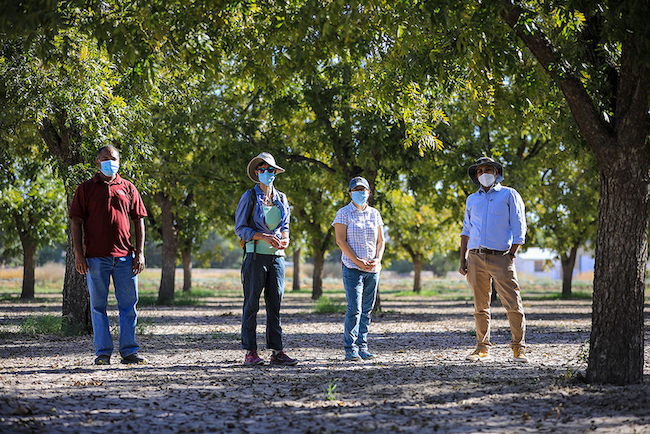
UTEP Leads Collaborative Abiotic CO2 Project Through $1.18 Million NSF Grant
Last Updated on November 08, 2020 at 12:00 AM
Originally published November 08, 2020
By Christina Rodriguez
UTEP Communications
The University of Texas at El Paso received a $1.18 million grant from the National Science Foundation (NSF) to learn more about greenhouse gas abiotic carbon dioxide (CO2) dynamics in dryland systems through the study of irrigated pecan orchards throughout the El Paso region.

The “Signals in the Soil” program is led by a pair of UTEP faculty members – principal investigator Lixin Jin, Ph.D., associate professor of geology, and co-PI Marguerite Mauritz-Tozer, Ph.D., research assistant professor of biology. They are collaborating with faculty members Saurav Kumar, Ph.D., water specialist, and Girisha Ganjegunte, Ph.D., water resources and salinity management research group leader at the Texas A&M University AgriLife Research Center at El Paso.
“This new endeavor underlines the importance of interdisciplinary research by combining a diverse approach to bio-geosciences, and it takes advantage of novel developments in remote sensing techniques,” said Robert A. Kirken, Ph.D., dean of UTEP’s College of Science. “This creative data collection over a broader study area will augment our understanding of the CO2 dynamics in dryland agricultural systems. The approach that Dr. Jin and the other investigators are pursuing will spearhead future applications to a wider range of studies that explore the linkage between soil dynamics, gas exchange and ecology. The study is local, but the impact will be global.”
Arid agricultural soils are very vulnerable to salt accumulation, and once soil becomes salty, it is almost useless for crop production. Intensification of dryland agriculture leads to water depletion and pushes farmers to rely more heavily on groundwater. Groundwater is more mineral-rich than surface water, and leads to faster carbonate and salt accumulation.
Greater understanding of the interactions between water supplies, soil health and crop health is essential for developing more sustainable approaches to dryland agriculture. The joint project will combine well-established and novel methods for detecting abiotic CO2 production during calcium carbonate formation associated with irrigation in arid agricultural soils. The traditional methods are expensive, labor intensive and confined to a single location. The research team’s proposed novel technology will use unmanned aerial vehicle (UAV)-based remote sensing techniques for scanning the air column above an agricultural site to detect changes in ground-level CO2 emission.
Researchers hope that the UAV-based scanning method will be suitable for rapid and larger-scale detection of enhanced CO2 production that can be linked to periods of calcium carbonate formation.
“Our goal is that together these approaches will provide essential knowledge for what conditions enhance calcium carbonate formation and abiotic CO2 production, and give us a method to model and predict abiotic CO2 contributions from dryland agriculture across much larger areas,” Jin said.
This collaborative effort is among the first in the U.S. Southwest to define critical links between flood irrigation, salt loading and abiotic CO2 exchange with the atmosphere. Researchers plan to build on existing data about abiotic CO2 production in dryland agricultural soils collected by Jin. This endeavor also will form an important linkage with the recent $5.27 million NSF-funded dryland critical zone project, also led by Jin.
“This is the latest in the line of several collaborative projects that had researchers both from UTEP and Texas A&M AgriLife Research at El Paso,” Kumar said. “These collaborative projects allow us to synergistically apply our resources and expertise to work on local problems, particularly related to water, soils and agricultural sustainability, while pushing the scientific frontiers that may be beneficial globally.”
The NSF grant provides the team the opportunity to transform initial studies into a richer understanding of the spatial and temporal variation in abiotic CO2 production and calcium carbonate formation. The project also could lay the groundwork for modeling and predicting the importance of abiotic CO2 and calcium carbonate processes in dryland regions throughout the globe.
“This project will examine a lesser-known aspect of the carbon cycle – abiotic CO2 flux during calcium carbonate formation,” Mauritz-Tozer said. “The role of these abiotic CO2 fluxes in the carbon cycle remains unresolved. This project is also an opportunity to explore the possibilities for sustainable dryland agricultural practices. I have studied the biotic carbon cycle in natural systems for most of my career, and this is an exciting opportunity to delve into two new branches of carbon cycling – the agricultural, human-dominated setting and the role of soil minerals for abiotic CO2 cycling.”
